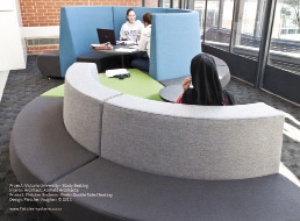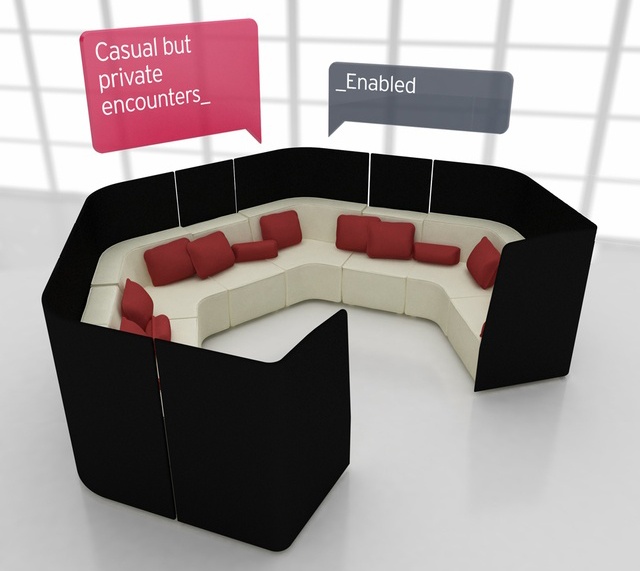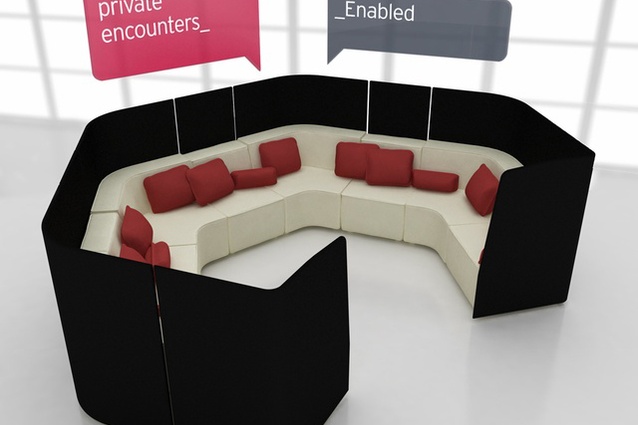Thinking Furniture
Turning theory into application, Blair McKolskey proposes that furniture — and not structural design interventions — will be at the forefront of office innovation in the future.
What if property wasn’t the only investment decision property managers made? What if furnishings could be shown to increase profit? What if having a better work environment wasn’t a desirable trait that is difficult to justify? What if the conversation around furnishings wasn’t one driven by the management of expenses? What if we could have a better workspace, have high-value furnishings we aspire to and by doing so make the company more money?
Furniture can be an investment if benefits can be measured
If workplace furniture was treated as an ‘investment’, not as an expense, then we may be on the verge of a fundamental paradigm shift. First, let’s clarify the term Investment. “Investment”, a definition: In finance, the purchase of a financial product or other item of value with an expectation of favourable future returns.1
Not many would view furniture as an item in which you expect or hope to make more money from. It is typically viewed as a utilitarian item or one that has benefits that are too ethereal to quantifiably measure. Not everyone will be interested in technical investment but one thing we have learned is that everyone likes to make money, especially if you can make money and enjoy the process too. For years, workplaces have struggled with the cost and benefit analysis of having better versus functional but cheaper workspaces. One thing we are certain of today is change – and often rapid change. Through the evolution of cubism, hotelling, hot desking and current trends around collaboration, property and facility managers have had to walk a fine line between optimising workspaces and the budget constraints of the board. Change will impact on work productivity; better work spaces generate positive results through pride, morale and ergonomics. But the challenge that has kept furniture in the category of expense has been our ability to monitor and directly measure the benefits.
How do you measure benefits?

We simply need to measure the improvements in productivity. But how? Unfortunately the “how” is the holy-grail for academics, architects, property managers and furniture companies alike. The body of knowledge around this area is extensive and there is no single approach. The key appears to be measurement in context of the individual company, group or individual and focus on relative outputs. Despite extensive research by PhDs and commercial enterprise, it is still too complicated to be straightforward but it is important that we continue to develop this strain. We would argue the challenge for us in New Zealand is more significant. To improve our standard of living relative to the rest of the world’s developed nations we must improve output of our productive assets. And given more and more of our manufacturing is moving offshore, it is our service-based sectors that are a growing share of GDP and importance to our standard of living.
Challenges of measurement
Pursuit of measurement started decades ago and presented numerous challenges, particularly in businesses where value creation is a function of cognitive abilities (service-based companies). Our ability to measure industrial output improvements through Kaizen, Lean and Theory of Constraints is well documented. It is not easy, however, to measure intellectual functions in the same manner we count widget outputs off an assembly line. Much of the challenge is a function of the complex process of measuring “thought” processes and correlating it to output. There is also the mismatch between controlled academic studies and the practical world or workplaces.
Observations in workplace behaviours
Research is showing us the ways in which we can begin to measure productivity improvements in cognitive work environments. Some observations we have made include a number of key findings: workers have frequent small blocks of uninterrupted time punctuated by brief and frequent conversations. Research from as far back as 19902 found that the average duration of uninterrupted work was less than 10 minutes for cognitive workers in a software firm. The resulting multiple numbers of tasks in various states of progress is due to the requirement to collaborate with colleagues. Often, this is in the form of needing to check facts, set up meetings, or get help to move tasks forward. Most face-to-face interactions are opportunistic or spontaneous rather than planned. These collaborations are a result of spatial visibility that make colleagues available for spontaneous conversations. The ability to identify who is in the workspace, where they are and what are they doing is important in facilitating spontaneous collaboration. Deliberate movement to collaborate or engage in conversation drops off dramatically after 30 metres. Research in 19713 found that distances greater than 30 metres are the equivalent of being in different buildings. Even within the 30 metres, those closer communicate more than those at a distance.
Examples of measurement
Application of this research generated concepts such as radical collocation which had measurable productivity gains. In this research software teams were moved into a single project area for a specific period and resulted in repeated shortened duration on projects compared to baseline projects. The proximity of the team to each other facilitated more frequent, shorter and more effective collaboration that improved project delivery (and fee generation) time by approximately 50%4. Radical collocation effectively facilitated in express collaboration between colleagues but also created an osmosis style transfer of knowledge between team members. The power of collaboration is well understood. Yet conflicting the benefits of collaborative spaces is the near universal desire to selectively isolate for distraction free work. Research over six years, 13,000 people and 40 businesses5 identified this trait as the most desired trait of workers. This is easy to understand. If the core contribution to the team is the application of the mind, there will inevitably be times where there will be a need to block the outside world to allow periods of concentration. Emphasising the importance of empowering workers to selectively isolate is research from Dr Craig Knight, who recently presented to the CoreNet group in Auckland. Dr Knight’s research shows that empowered work spaces have lead to productivity gains on average of 32%. The result for property and facilities managers is to have properties that are flexible in design to encourage spontaneous collaborations yet allowing selective periods of isolation. Efforts by formidable companies such as Haworth indicate that the furnishing component will be the mechanism for delivering the requirements. Structural elements are not likely to provide for the open design required for spontaneous interactions. In addition, the way we are working now is driving a softer work environment. No longer is it about work-life balance. It is life-life balance. With iPads, Blackberrys, cloud computing and social technology, we are just as likely to be working at 10pm from home, answering emails, as we are to be checking Facebook from 9 to 5. Haworth’s Soft Shelter system, Fletcher Systems’ Realm and Finewood’s new Scott and Blox units are examples of theory transformed into application.

Local examples
Each design fits in with the trend of general softening of workspaces, encourages quick easy collaborations yet allows for spontaneous meetings to be held in ways that do not disrupt those involved in concentrated work. Each is positioned as a meeting space as opposed to traditional categorisation of sofa or seat system. Further advances in design applied to ceiling tiles, partitions, and workstations are evidence of this trend.
Conclusion
We expect to see growing use of furniture as a meeting space, and meeting spaces being merged into workstation spaces. However, the meeting spaces will facilitate individual selective isolation likely in the form of acoustic panel products. We expect that research will give us a clearer process for measuring productivity benefits. This will come as a result of innovative companies applying research that reflects local knowledge and cultural norms. We expect that furnishing, not structural design, will lead the next generation in workspace function and for this trend to be particularly pronounced in New Zealand where economic and social norms are fertile grounds. Haworth, Finewood and Fletcher Systems argue they already do this. What is now required is for the research to be applied locally and advance these concepts.
Footnotes:
1. www.investorwords.com/2599/investment.html
2. Reder, S and Schwab R.G. 1990, The temporal structure of cooperative activity in CSCW‘90 Proceedings. ACM Press.
3. Allen, T.J. 1991, Communications network in R&D laboratories, R&D Management.
4. Teasely, S., Covi, L., Krishnan, M.S., How does radical collocation help a team succeed?, Proceedings of CWCW 2000
5. Michael Brill; Sue Weidemann; and John Olson and Ellen Keable; BOSTI Associates; Disproving Widespread Myths About Workplace Design; Kimball International










